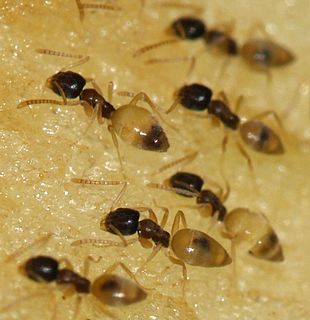
Dolichoderinae is a subfamily of ants, which includes species such as the Argentine ant, the erratic ant, the odorous house ant, and the cone ant. The subfamily presents a great diversity of species throughout the world, distributed in different biogeographic regions, from the Palearctic, Nearctic, Afrotropical region and Malaysia, to the Middle East, Australian, and Neotropical regions.

Tapinoma is a genus of ants that belongs to the subfamily Dolichoderinae. The genus currently comprises 74 described species distributed worldwide in tropical and temperate regions. Members of are generalized foragers, nesting in a wide variety of habitats, ranging from grasslands, open fields, woodlands, to inside buildings. The majority of species nest in the ground under objects such as stones or tree logs, other species build nests under bark of logs and stumps, in plant cavities, insect galls or refuse piles.

Aphaenogaster is a genus of myrmicine ants. About 200 species have been described, including 18 fossil species. They occur worldwide except in South America south of Colombia, Sub-Saharan Africa, and Antarctica.

Crematogaster is an ecologically diverse genus of ants found worldwide, which are characterised by a distinctive heart-shaped gaster (abdomen), which gives them one of their common names, the Saint Valentine ant. Members of this genus are also known as cocktail ants because of their habit of raising their abdomens when alarmed. Most species are arboreal. These ants are sometimes known as acrobat ants.

Tetramorium is a genus of ants in the subfamily Myrmicinae that includes more than 520 species.

Tetraponera is a genus of ants in the subfamily Pseudomyrmecinae that are commonly known as slender ants and are characterized by their arboreal nature and slender bodies. The 86 described species of Tetraponera all live in hollow structures of plants and trees, such as thorns or branches; these hosts are known as myrmecophytes. Tetraponera species are closely related to the New World genus of ants Pseudomyrmex, but differ in their relationships with host plants.

Dolichoderus is a genus of ants found worldwide.

Technomyrmex is a genus of ants in the subfamily Dolichoderinae. With 98 species, it is one of the largest and most diverse ant genera in the Dolichoderinae. The genus distributed throughout the tropical and subtropical zones with most species occurring in the Oriental-Malesian and Afrotropical regions. One species, Technomyrmex albipes is a tramp ant now widespread throughout the tropics due to human activities.

Carebara is a genus of ants in the subfamily Myrmicinae. It is one of the largest myrmicine genera with more than 174 species distributed worldwide in the tropics and the Afrotropical region. Many of them are very tiny cryptic soil and leaf litter inhabitants. They nest in rotten wood to which the bark is still adherent in the Afrotropical region, or may be lestobiotic nesting near other ant species. Some species are known to exist parasitically within termite nests. Little is known about the biology of the species. However, they are notable for the vast difference in size between queens and workers.

Liometopum luctuosum is a species of ants in the subfamily Dolichoderinae. Liometopum luctuosum is often mistaken for carpenter ants by homeowners and pest management professionals. This mistaken identity is due to morphological and behavioral characteristics they share with carpenter ants; namely polymorphic workers, a smooth convex thoracic profile, and the tendency to excavate wood. L. luctuosum are also often confused with the Tapinoma sessile since they have the same coloration, are similar in size, and produce an alarm pheromone with a very similar odor. Consequently, their importance as structural pests may be greatly under reported, especially in California, Oregon, and Washington, United States.

Iridomyrmex chasei is an ant belonging to the genus Iridomyrmex. The species was described by Forel in 1902, the species is mainly abundant nationwide in Australia, with an exception of its presence in Tasmania. This species is widely known for its large and highly populated nests.

Tapinomini is a tribe of Dolichoderinae ants with 6 genera and one extinct genus.

Liometopum imhoffii is an extinct species of ants in the dolichoderine genus Liometopum. The species was described from a number of Early Miocene fossils found in what is now Croatia.

Liometopum microcephalum is a species of ant in the genus Liometopum. Described by Panzer in 1798, the species is endemic to Europe.
Tapinoma heyeri is a species of ant in the genus Tapinoma. Described by Forel in 1902, the species is endemic to Brazil.
Pheidole spathifera is a species of ants in the subfamily Myrmicinae. It is found in Asian countries.
Camponotus clarior is a species of ant in the genus Camponotus. Described by Forel in 1902, the species is native to Australia.
















